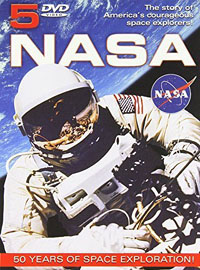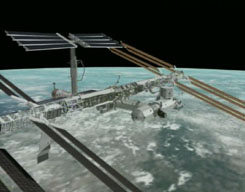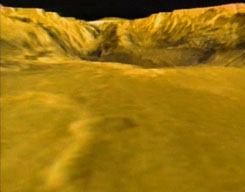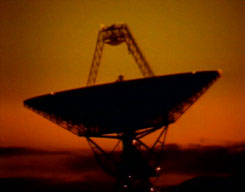"NASA: 50 Years of Space Exploration"
|
|
Madacy Entertainment Group has here gathered up a bunch
of old low-to-no-cost NASA films, and dumped them onto a
five-disc DVD set. The discs and packaging
look nice and professional - but unfortunately nothing has been done to restore any of these
films and videos before reproducing them, which is highly disappointing. The content is
otherwise fascinating, from the point of view of space exploration, flight craft engineering,
and also historical development of our world view and reporting techniques.
Well, the world is now entering a new era in which many acronym agencies like NASA are getting their lies and secrets exposed like never before. What are we to believe about space exploration as these kinds of discoveries are revealed? My own personal take is that, of course NASA has been involved in secrecies, quite easily outright lies as well... but I think in most cases this is to hide their capabilities and the things they know, not to try to boost themselvses and claim capabilities that they didn't have. So for example, to the question of whether or not the moon landings are fake, I will say that I believe NASA did send actual missions to the moon, and probes to the other planets of the solar system. I don't think we the public get to see all of the photos and films and fully complete sets of data. On top of this, NASA may indeed have faked some photos/films to put out in place of the real photos/films that they couldn't show us. Plus, I think there are nutcases paid to create fake stuff and then debunk it, to deliberately discredit people or ideas, create confusion and mass pliability. So... use your own discernment in everything. Here is some of what NASA put out for public consumption over the years. What follows is a more detailed breakdown of the chapters on each disc and the various films contained within.... | -Lyratek Main Page |
|
||||||||||||
| Episodes: | ||||||||||||
|---|---|---|---|---|---|---|---|---|---|---|---|---|
| 1 |
|
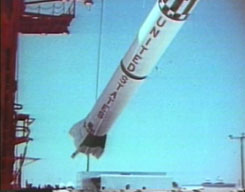
|
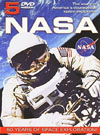
|
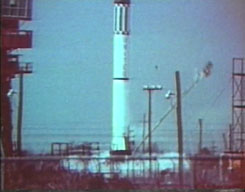
|
||||||||
| 2 |
|
 |
||||||||||
| 3 |
|
 |
||||||||||
| 4 |
As good as this film is, it's hard to tell who is doing what. Is that Eugene Kranz speaking on camera? How about an identifying subtitle? Neil Armstrong and Jim Lovell are mentioned often, and David Scott once, but which of them are amongst the two astronauts in the Gemini 8 capsule? This is not established in the film; I find myself looking elsewhere to confirm that Armstrong and Scott flew in the capsule, while Lovell was in charge of mission communication on the ground in Houston. |
 |
||||||||||
| 5 |
directed by Ted Lowry edited by Bastian Wimmer This film is actually quite a satisfying recounting of the historic flight of Neil Armstrong, Edwin "Buzz" Aldrin, and Michael Collins to the surface of the moon. Many pieces of now famous footage are played out here at greater length than usual, although still often not completely at full length. Many of the quotes and speeches on the audio track aren't really synced to visuals of the person speaking, and I often couldn't be sure who was talking. Still, this is definitely the best of the five films on this disc by far. |
 |
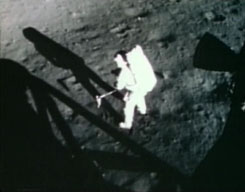
|
|||||||||
| 6 |
edited by Richard L. Atwell This film combines a lot of media news coverage and interviews of NASA personnel with NASA footage and audio interviews of the three astronauts, as it tells the tale of the aborted moon landing of Apollo 13 that turned into a long series of challenges for space survival. Produced by an outside company for NASA, it is bizarre in its choice to use steel drum band music throughout, ending on an upbeat calypso. Nevertheless, the prolific interviews that include Donald K. "Deke" Slayton and director Eugene Kranz are something that previous films needed more of, and help boost this film's ranking accordingly. |
 |
||||||||||
| 7 |
edited by Richard L. Atwell This is one of the most interesting films ever about manned lunar exploration. Geological discoveries take over from engineering logistics for once, which proves to be an excellent trade-off. This is the first lunar landing to deploy a rover car. Astronauts Dave Scott and Jim Irwin land at Hadley Rille, and collect many rocks, including drilled core samples with 58 layers, a find of crystalline, and the "genesis rock". Scott also drops a hammer and feather at the same time, to test Galileo's theory in moon gravity. They also launch a satellite designed to orbit the moon for a year. It's a pity some of the footage is so blurry or overexposed as it would otherwise be spectacular. (Proper restoration, anyone?) I also wonder if the exact same shot of driving up a hill beside a mountain was used 3 times to represent different legs of their journey. |
 |
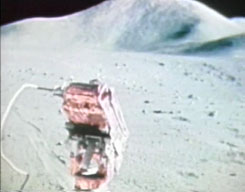
|
|||||||||
| 8 |
edited by Brian Beasley The multitude of minor malfunctions on this mission don't seem to faze the enthusiasm of John Young and Charles Duke going to land on the moon, or Ken Mattingly orbiting above them, resulting in one of the most jovial and goofy lunar landing missions ever - and certainly keeping big smiles on everyone at mission control in Houston. Highlights include discoveries of huge black rocks in large craters, some with mysterious "drill holes" already in them. There's also footage here of lunar rover "stunts", and high-jumping salutes. |
 |
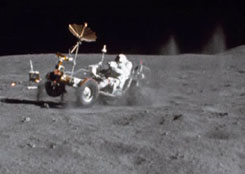
"Yahoo!!" - Poppin' a Wheelie & Kickin' up a Batch of Moondust |
|||||||||
| 9 |
edited by Brian Beasley Here we follow the exploits of Commander Eugene Cernan, geologist Dr. Harrison "Jack" Schmidt, and orbital module pilot Ronald Evans on their trip to the moon aboard Apollo 17 in December 1972. Though they take along a lunar rover, there isn't any footage of it doing any driving around, just a bit of a fender repair which looks suspiciously like a clean up of Apollo 16's mess. There is a fair bit of fumbling about in bulky suits in low gravity here. The highlight is the discovery of red-orange soil under the grey dust in one region, though time pressures the team to not investigate as fully as they would ideally have liked. It seems to be widely known and accepted that this will be the last mission to the moon for a long time, and the film plays to that melancholy sentiment. Many personnel at mission control are interviewed, though we really don't get a good idea of what they are doing. Half of the interviews point ahead to new space projects like Apollo-Soyuz, Skylab, and the space shuttle prototype. Since these future projects are ultimately less interesting than Cernan and company on the moon, hyping them only serves to make this the most de-focused of all the Apollo moon mission films. |
 |
||||||||||
| 10 |
edited by Chuck Welch This film documents the political motivation, planning, and execution of the first docking between American and Russian spacecraft. The charismatic Alexei Leonov (first human EVA) leads the soviet craft with V. Kubasov (first welder in space), while the American Apollo is manned by Air Force General Thomas Stafford (Apollo 10), Deke Slayton (original Mercury 7), and Vance Brandt. The film has many dull sections, but the main sentiment is powerful, the bits of Russian language filtering in are interesting, and some of the experiments tested in space are intriguingly unique. Not bad. |
 |
||||||||||
| 11 |
|
 |
||||||||||
| 12 |
edited by Anton Novelli directed by John Nicholas Hosted by E.G. Marshall and taking its title from a tongue-in-cheek play on newspaper apartment listings, this film covers all three 1973 missions to the Skylab space station. The re-run of Skylab's initial launch complications is a dull section, but after this the film focuses nicely on the various scientific discoveries made possible by the Skylab environment. You can feel this film serving the added purpose of justifying continued funding of NASA in the public's eye. In conclusion, it seems that no further trips to Skylab were in the works, although it was thought that Skylab's orbit could last another ten years. |
 |
||||||||||
| 13 |
The Orbital Test Flights of the Space Transportation SystemThis film covers the first four space shuttle missions into orbit, STS-1 through STS-4, all apparently flown by the Columbia. Documented are the various firsts for the system on each flight, as well as a long list of scientific experiments carried out. The fourth landing features a major goal setting speech by president Ronald Reagan, given in front of the test shuttle Enterprise and a huge crowd. |
 |
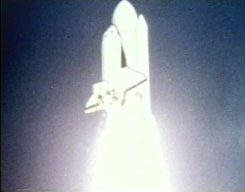
|
|||||||||
| 14 |
Summary of Shuttle Flights 5, 6, 7 and 8Operational flights begin with STS-5 for the shuttle Columbia, and continue with flights 6, 7, and 8 for the new shuttle Challenger, as their crews are gradually increased to four people, then five. An average of two satellites are launched from each flight, with later flights picking up a few out of orbit as well. The first of three proposed Tigress satellites gets a lot of coverage, much from animation, as it interacts with several missions in sequence and has some trouble with its trajectory. Flight STS-7 also features the first American woman in space, Sally K. Ride. Shuttles Discovery and Atlantis are still being built at this time. Unfortunately, the audio transfer from film is too compressed, squeezing quiet bits into silence. |
 |
||||||||||
| 15 |
|
 |
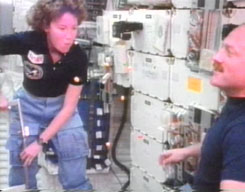
|
|||||||||
| 16 |
|
 |
||||||||||
| 17 |
The second section "Space Shuttle Challenger Accident Investigation" is not so much a documentary as a 30 minute presentation of evidence for legal and re-design purposes - a very dry and matter-of-fact layout of findings from film footage, photos, telemetry, and physical evidence building a case of a design weakness. |
Included Items:
|
||||||||||
| 18 |
(no on-screen director credit) This documentary presents a short history of NASA's achievements over its first 25 year history, beginning with a recap of the NACA aviation organization begun in 1915 which later became NASA on October 1, 1958 when our real story began. The first section covers early satellite history, introduces us to the Mercury Seven astronauts, and covers the American/Soviet space race to the moon. The next section covers a variety of subjects, including space stations and science missions, and automated space probes from the Mariner, Viking, Pioneer, and Voyager series traveling to Venus, Mars, and beyond. Findings at Jupiter, its four big moons, and at Saturn are discussed. Voyager 2's trips to Uranus and Neptune remain in the future tense at the time of this film's production. Finally, the space shuttle program is recounted at some length, as most of its early missions are recounted in some detail. The only speaking figures appearing in this documentary are U.S. presidents giving public speeches. Narration by Lary Lewman is quite good, however quite often the music is a bit too loud and busy. On the box set by Madacy Entertainment Group, the film transfer appears quick and dirty, without any real restoration or finesse. Imagery is a bit dark and blurry, and sound suffers from lack of balance and clarity. I'm sure the original film could be made to look and sound much better with some Tender Loving Care, which would make this a much more enjoyable piece. In the absence of a copyright notice, I'm assuming this was made in 1983. |
 |
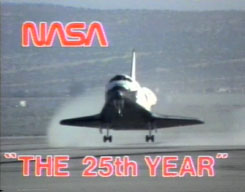
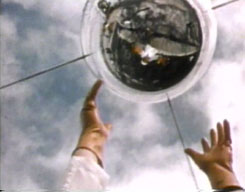
|
|||||||||
| 19 |
The first film gives a basic timeline of how the various modules of the ISS came together, beginning with the joining of the first two in 1998. This is quite a modern looking documentary, covering events up to about 2002. The second film is a bit more of a standard NASA operational document, with footage of ISS astronauts Bill Shepherd, Susan Helms, and others going into more specifics about their missions. The third film "ISS: Realizing the Dream" (10 min.) goes wild interviewing dozens of personnel from many of the 16 different countries that contributed hardware and expertise to the various components, and it becomes a rich and exciting celebration of the international co-operation at the heart of this station. |
Included Items:
|
||||||||||
| 20 |
The second piece is titled "Sorce's Five Year Mission", which is like a live sportscast of the Sorce probe's launch, in which our hosts try to bring us up to speed on the solar instigated atmospheric phenomena this probe will measure and why that is important. They managed to totally lose me. Apart from the uniqueness of launching from the underbelly of an airplane, this mostly transitional piece is about as interesting as watching paint dry. |
Included Items:
|
||||||||||
| 21 |
|
 |
||||||||||
| 22 |
Section 3 largely resembles section 1 without being half as interesting, as Hubble is serviced in 2002 by another space shuttle crew. Section 4 is a brief and bizarre "promo" montage for Hubble and NASA - the music audio is pretty bad. Madacy then made the bizarre decision to nick the music, effects, and JFK speech from here for use on the menus of all 5 discs in this set, without cleaning any of it up first. |
Included Items:
|
||||||||||
| 23 |
The second item takes us on a tour outwards through the solar system, mentioning observations our probes have made on Mars, and while highlighting the Voyager probes, covering Jupiter, its moons Io, Ganymede, and Callisto, and Saturn. Nicely, speculation listed here entertains the idea that the asteroid belt might be the remains of a planet. (Maldek, anyone?) Also mentioned quickly are Europa, Uranus, and Neptune. The narration is careful to hide the fact that the Voyager probes did not actually visit Pluto as it is discussed, before quickly mentioning the scale of interstellar distances and our sun's place in orbit around the galaxy. |
Included Items:
|
||||||||||
| 24 |
All other items focus on Columbia's last flight: STS-107 in January 2003. All seven crewmembers give pre-flight interviews about what inspired them to aim their careers toward space. We then get some footage from the launch, and a lot of footage of the scientific experiments that occupied much of the crew's time in space. We see the faces of mission controllers on Earth as contact with Columbia is lost during re-entry, 16 minutes away from touchdown. Finally, we get a sad montage of eulogies for the seven crewmembers and the Columbia spacecraft herself, from a variety of people including George Bush, Jr. There is no actual footage of the February 1st re-entry break-up of the craft, nor any of investigation of the cause. |
 |
||||||||||
| 25 |
|
 |
||||||||||
| ||||||||||||
| ||||||||||||

LYRATEK.COM |

LYRATEK.COM
|
